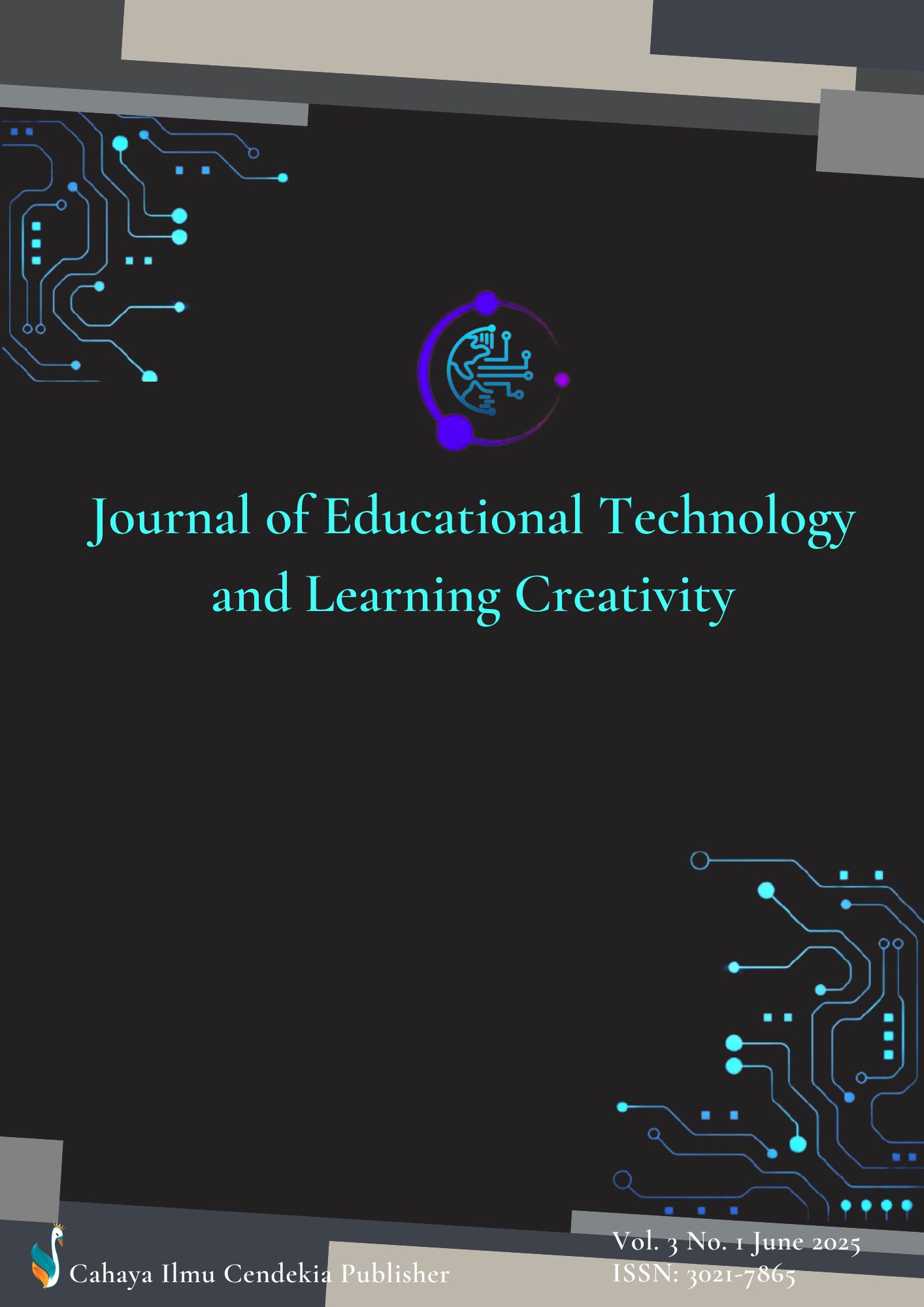The Influence of Using TikTok Social Media on Students' Social Interaction Levels
Abstract
Purpose of the study: This study aims to determine the effect of the level of use of TikTok social media on the level of students' social interaction.
Methodology: This type of research is quantitative with the expost facto method. The technique used in sampling is the purposive sampling technique with a sample size of 79 students. Instruments and data collection techniques were carried out using a questionnaire on the use of social media TikTok and social interaction. The data analysis technique used in this study is simple linear regression analysis with the help of the SPSS 24 program.
Main Findings: The study revealed that the influence of TikTok usage on the social interaction of Grade VII students at State Junior High School 17 Jambi City is 11.2% (or 0.112), which falls into the low but significant category. The level of TikTok use among students is 63.89%, categorized as high, while their level of social interaction is also high at 64.57%. Although the direct influence of TikTok on social interaction is relatively low, the high usage level warrants attention. Therefore, parents and guidance and counseling teachers are encouraged to supervise and monitor students' activities on social media to ensure it remains positive and constructive.
Novelty/Originality of this study: It is expected to add new insights and knowledge about the influence of social media on students' social interactions, so that teachers can work together with parents to help monitor children's social relationships.
References
S. A. Dar and D. Nagrath, “The impact that social media has had on today’s generation of indian youth: an analytical study,” Int. J. English Lit. Soc. Sci., vol. 7, no. 4, pp. 48–56, 2022, doi: 10.54443/morfai.v3i2.309.
R. Anthony et al., “Young people’s online communication and its association with mental well-being: results from the 2019 student health and well-being survey,” Child Adolesc. Ment. Health, vol. 28, no. 1, pp. 4–11, 2023, doi: 10.1111/camh.12610.
M. S. Islam et al., “Problematic smartphone and social media use among Bangladeshi College and University students amid covid-19: the role of psychological well-being and pandemic related factors,” Front. Psychiatry, vol. 12, no. April, pp. 1–12, 2021, doi: 10.3389/fpsyt.2021.647386.
S. Clarissa and J. Lobo, “Rising popularity of TikTok during the pandemic: utilization of the application vis-à-vis students’ engagement,” Am. J. Interdiscip. Res. Innov., vol. 1, no. 2, pp. 43–48, 2022, doi: 10.54536/ajiri.v1i2.699.
A. Bhandari and S. Bimo, “Why’s everyone on TikTok now? the algorithmized self and the future of self-making on social media,” Soc. Media Soc., vol. 8, no. 1, pp. 1–11, 2022, doi: 10.1177/20563051221086241.
J. Frey, K. J. Black, and I. A. Malaty, “TikTok tourette’s: are we witnessing a rise in functional tic-like behavior driven by adolescent social media use?,” Psychol. Res. Behav. Manag., vol. 15, pp. 3575–3585, 2022, doi: 10.2147/PRBM.S359977.
Z. O. Soluade, T. T. Otubanjo, S. A. Babatunde, and T. O. Idowu, “Impact of TikTok content on teenagers’ lifestyle and behaviours among senior secondary school students in Ogun State — Zabur Olayiwola Soluade,” Rima Int. J. Educ., vol. 4, no. 1, pp. 385–401, 2025, doi: 10.1101/pdb.caut2593.
A. Sair, A. P. Kusman, and S. Ladiqi, “The TikTok effect : exploring gender norms , lifestyle , and cultural shifts among Gen Z,” J. Soc. Media, vol. 9, no. 1, pp. 241–259, 2025, doi: 10.26740/jsm.v9n1.p241-259.
S. Syarifuddin, S. Triyono, F. Nur’ani, S. H. Rahmia, and R. Rusmaniah, “Analysis of the Tiktok social media phenomenon for students : a case study of the millennial generation,” Kalimantan Soc. Stud. J., vol. 6, no. April, pp. 209–220, 2025.
S. Mustoip, M. I. Al Ghozali, U. S. As, and S. Y. Sanhaji, “Implementation of character education through children’s language development in elementary schools,” IJECA (International J. Educ. Curric. Appl., vol. 6, no. 2, pp. 1–11, 2023, doi: 10.31764/ijeca.v6i2.14192.
A. Maksum, I. W. Widiana, and A. Marini, “Path analysis of self-regulation, social skills, critical thinking and problem-solving ability on social studies learning outcomes,” 2021. doi: 10.29333/iji.2021.14336a.
T. Silveira-Zaldivar, G. Özerk, and K. Özerk, “Developing social skills and social competence in children with autism,” Int. Electron. J. Elem. Educ., vol. 13, no. 3, pp. 341–363, 2020, doi: 10.26822/IEJEE.2021.195.
S. De Felice, A. F. D. C. Hamilton, M. Ponari, and G. Vigliocco, “Learning from others is good, with others is better: the role of social interaction in human acquisition of new knowledge,” Philos. Trans. R. Soc. B Biol. Sci., vol. 378, no. 1870, 2023, doi: 10.1098/rstb.2021.0357.
J. Li and W. Shao, “Influence of sports activities on prosocial behavior of children and adolescents: a systematic literature review,” Int. J. Environ. Res. Public Health, vol. 19, no. 11, pp. 1–20, 2022, doi: 10.3390/ijerph19116484.
I. H. M. Hatamleh et al., “Trust in social media: enhancing social relationships,” Soc. Sci., vol. 12, no. 7, pp. 1–22, 2023, doi: 10.3390/socsci12070416.
I. A. Nada, G. A. Ayua, and O. E. Odiri, “The role of social media in shifting communication patterns and societal lifestyle changes,” in International Seminar on Student Research in Education, Science, and Technology, 2024, pp. 591–598.
F. Gioia, G. Fioravanti, S. Casale, and V. Boursier, “The effects of the fear of missing out on people’s social networking sites use during the covid-19 pandemic: the mediating role of online relational closeness and individuals’ online communication attitude,” Front. Psychiatry, vol. 12, no. February, pp. 1–11, 2021, doi: 10.3389/fpsyt.2021.620442.
E. Al-Jbouri, A. A. Volk, N. Spadafora, and N. C. Z. Andrews, “Friends, followers, peers, and posts: adolescents’ in-person and online friendship networks and social media use influences on friendship closeness via the importance of technology for social connection,” Front. Dev. Psychol., vol. 2, pp. 01–15, 2024, doi: 10.3389/fdpys.2024.1419756.
A. J and J. Sutcliffe, “The use of social media such as Whatsapp, Youtube and Instagram in enhancing rather than impeding the learning of college students: an investigative case study,” J. Educ. Soc. Sci., vol. 22, no. 1, pp. 1–11, 2022.
D. Menon, “Updating ‘Stories’ on social media and its relationships to contextual age and narcissism: a tale of three platforms – WhatsApp, Instagram and Facebook,” Heliyon, vol. 8, no. 5, p. e09412, 2022, doi: 10.1016/j.heliyon.2022.e09412.
S. Boulianne, C. P. Hoffmann, and M. Bossetta, “Social media platforms for politics: a comparison of Facebook, Instagram, Twitter, YouTube, Reddit, Snapchat, and WhatsApp,” New Media Soc., vol. 00, no. 0, pp. 1–32, 2024, doi: 10.1177/14614448241262415.
Q. Jia, X. Xu, M. Zhou, H. Liu, and F. Chang, “Exploring the determinants of continuous intention in TikTok from the perspective of social influence: a mixed approach of SEM and fsQCA,” J. Electron. Bus. Digit. Econ., vol. 2, no. 1, pp. 45–68, 2023, doi: 10.1108/jebde-07-2022-0016.
T. G. Ginting, “Forming a solid foundation: the role of early childhood education in character development,” Solo Univers. J. Islam. Educ. Multicult. E, vol. 2, no. 1, pp. 71–82, 2024.
S. Sarbaitinil, R. Rudagi, I. Rahmat, N. Elfemi, and I. Isnaini, “Expressing philosophical discourse in pencak silat as a pillar of character education and strengthening social ties in society,” J. Pragmat. Discourse Res., vol. 3, no. 2, pp. 150–162, 2023, doi: 10.51817/jpdr.v3i2.301.
V. Zelenin, “The role of social networks in shaping the identity and self-realisation of young people,” Amaz. Investig., vol. 13, no. 84, pp. 291–303, 2024.
Nazmine, A. Khalid, K. Z. Chishti, and H. K. Tareen, “New media technologies and society: a study on the impact of new media technology on interaction patterns of youth,” no. May, pp. 66–77, 2021, [Online]. Available: https://www.researchgate.net/publication/351955632
S.-N. Voicu and I. Crăciun, “Preventive online safety education for teenagers,” Int. J. Leg. Soc. Order, vol. 3, no. 1, pp. 571–579, 2023, doi: 10.55516/ijlso.v3i1.165.
M. S. Putri et al., “Exploring digital literacy among high school students : the role of environment assistance,” J. Educ. Dev. Inst., vol. 12, no. 2, pp. 140–145, 2024, doi: 10.37081/ed.v12i2.5784.
N. Nurhidayatullah, N. Ayu, and S. Herawati, “Analysis of price and product quality on impulsive buying on online shopping platforms islamic economic approach,” vol. 3, no. 3, 2025.
R. Jensen, “Exploring causal relationships qualitatively: an empirical illustration of how causal relationships become visible across episodes and contexts,” J. Educ. Chang., vol. 23, no. 2, pp. 179–196, 2022, doi: 10.1007/s10833-021-09415-5.
M. M. Dhodapkar, X. Shi, R. Ramachandran, E. M. Chen, J. D. Wallach, and J. S. Ross, “Characterization and corroboration of safety signals identified from the US Food and Drug administration adverse event reporting system, 2008-19: cross sectional study,” BMJ, pp. 1–10, 2022, doi: 10.1136/bmj-2022-071752.
G. Carloni, A. Berti, and S. Colantonio, “The role of causality in explainable artificial intelligence,” Wiley Interdiscip. Rev. Data Min. Knowl. Discov., vol. 15, pp. 1–22, 2025, doi: 10.1002/widm.70015.
F. Nyimbili and L. Nyimbili, “Types of purposive sampling techniques with their examples and application in qualitative research studies,” Br. J. Multidiscip. Adv. Stud., vol. 5, no. 1, pp. 90–99, 2024.
S. K. Ahmed, “How to choose a sampling technique and determine sample size for research: a simplified guide for researchers,” 2024, Elsevier Ltd. doi: 10.1016/j.oor.2024.100662.
K. R. Subedi, “Determining the Sample in Qualitative Research,” Sch. J., vol. 4, no. December, pp. 1–13, 2021, doi: 10.3126/scholars.v4i1.42457.
M. E. Hendriyani, I. Rifqiawati, and D. Lestari, “Online learning videos to develop creative thinking skills of students,” Res. Dev. Educ., vol. 2, no. 2, pp. 67–75, 2022, doi: 10.22219/raden.v2i2.20035.
Sarwanto, L. E. W. Fajari, and Chumdari, “Open-ended questions to assess critical-thinking skills in Indonesian elementary school,” Int. J. Instr., vol. 14, no. 1, pp. 615–630, 2020, doi: 10.29333/IJI.2021.14137A.
A. Astalini, D. A. Kurniawan, D. K. Sari, and W. Kurniawan, “Description of scientific normality, attitudes of investigation and interested career on physics in senior high school,” JIPF (Jurnal Ilmu Pendidik. Fis., vol. 4, no. 2, p. 56, 2019, doi: 10.26737/jipf.v4i2.885.
J. Paul and M. Barari, “Meta-analysis and traditional systematic literature reviews—what, why, when, where, and how?,” Psychol. Mark., vol. 39, no. 6, pp. 1099–1115, 2022, doi: 10.1002/mar.21657.
Y. Hu and L. Plonsky, “Statistical assumptions in L2 research: A systematic review,” Second Lang. Res., vol. 37, no. 1, pp. 171–184, 2021, doi: 10.1177/0267658319877433.
A. Ghanad, “An overview of quantitative research methods,” Int. J. Multidiscip. Res. Anal., vol. 06, no. 08, pp. 3794–3803, 2023, doi: 10.47191/ijmra/v6-i8-52.
M. Misbahudholam AR, A. Asmoni, K. Aini, and M. Wardi, “The relationship of the 5th batch campus teaching program to literacy and numeracy skills in elementary schools,” AL-ISHLAH J. Pendidik., vol. 16, no. 2, pp. 1999–2011, 2024, doi: 10.35445/alishlah.v16i2.4958.
J. M. Sumilat, R. M. S. Tuerah, and B. Setiawan, “The utilization of online media in calculation operations mathematics learning in elementary school students,” J. Educ. Soc. Res., vol. 12, no. 3, pp. 90–97, 2022, doi: 10.36941/jesr-2022-0069.
D. Alita, A. D. Putra, and D. Darwis, “Analysis of classic assumption test and multiple linear regression coefficient test for employee structural office recommendation,” IJCCS (Indonesian J. Comput. Cybern. Syst., vol. 15, no. 3, p. 295, 2021, doi: 10.22146/ijccs.65586.
R. Parekh, “Comparison analysis of construction costs according to LEED and non-LEED certified educational buildings,” J. Emerg. Technol. Innov. Res., vol. 11, no. 8, pp. 1–8, 2024.
R. Chetty et al., “Social capital II: determinants of economic connectedness,” Nature, vol. 608, no. 7921, pp. 122–134, 2022, doi: 10.1038/s41586-022-04997-3.
T. Hennig-Thurau, D. N. Aliman, A. M. Herting, G. P. Cziehso, M. Linder, and R. V. Kübler, “Social interactions in the metaverse: Framework, initial evidence, and research roadmap,” J. Acad. Mark. Sci., vol. 51, no. 4, pp. 889–913, 2023, doi: 10.1007/s11747-022-00908-0.
M. Misaki et al., “Beyond synchrony: The capacity of fMRI hyperscanning for the study of human social interaction,” Soc. Cogn. Affect. Neurosci., vol. 16, no. 1–2, pp. 84–92, 2021, doi: 10.1093/scan/nsaa143.
J. R. Izharsyah, J. T. Ibrahim, O. Sukmana, and D. Hartanto, “The Social Interaction Pattern in the Indonesian City of Medan’s Deli Malay Coastal Community,” Eur. J. Humanit. Soc. Sci., vol. 3, no. 1, pp. 66–75, 2023, doi: 10.24018/ejsocial.2023.3.1.390.
J. Hohenstein et al., “Artificial intelligence in communication impacts language and social relationships,” Sci. Rep., vol. 13, no. 1, pp. 1–9, 2023, doi: 10.1038/s41598-023-30938-9.
H. K. Azzaakiyyah, “The impact of social media use on social interaction in contemporary society,” Technol. Soc. Perspect., vol. 1, no. 1, pp. 1–9, 2023, doi: 10.61100/tacit.v1i1.33.
H. Susanto, L. F. Yie, F. Mohiddin, A. A. R. Setiawan, P. K. Haghi, and D. Setiana, “Revealing social media phenomenon in time of COVID-19 pandemic for boosting start-up businesses through digital ecosystem,” Appl. Syst. Innov., vol. 4, no. 1, pp. 1–21, 2021, doi: 10.3390/asi4010006.
M. Putri, E. W. Abbas, J. Jumriani, B. Subiyakto, and M. A. H. Putra, “Contribution of social interaction materials to the establishment of social institutions in the social studies student’s book class VII,” Kalimantan Soc. Stud. J., vol. 3, no. 2, p. 110, 2022, doi: 10.20527/kss.v3i2.3685.
S. Fabriz, J. Mendzheritskaya, and S. Stehle, “Impact of synchronous and asynchronous settings of online teaching and learning in higher education on students’ learning experience during covid-19,” Front. Psychol., vol. 12, no. October, 2021, doi: 10.3389/fpsyg.2021.733554.
Copyright (c) 2025 Sofiatun Nisa, Hasnah Mohamed, Montree Yamkasikorn

This work is licensed under a Creative Commons Attribution 4.0 International License.
Authors who publish with this journal agree to the following terms:
- Authors retain copyright and acknowledge that the Journal of Educational Technology and Learning Creativity is the first publisher licensed under a Creative Commons Attribution 4.0 International License.
- Authors are able to enter into separate, additional contractual arrangements for the non-exclusive distribution of the journal's published version of the work (e.g., post it to an institutional repository or publish it in a book), with an acknowledgment of its initial publication in this journal.
- Authors are permitted and encouraged to post their work online (e.g., in institutional repositories or on their website) prior to and during the submission process, as it can lead to productive exchanges and earlier and greater citation of published work.


.png)


.png)
.png)
.png)












